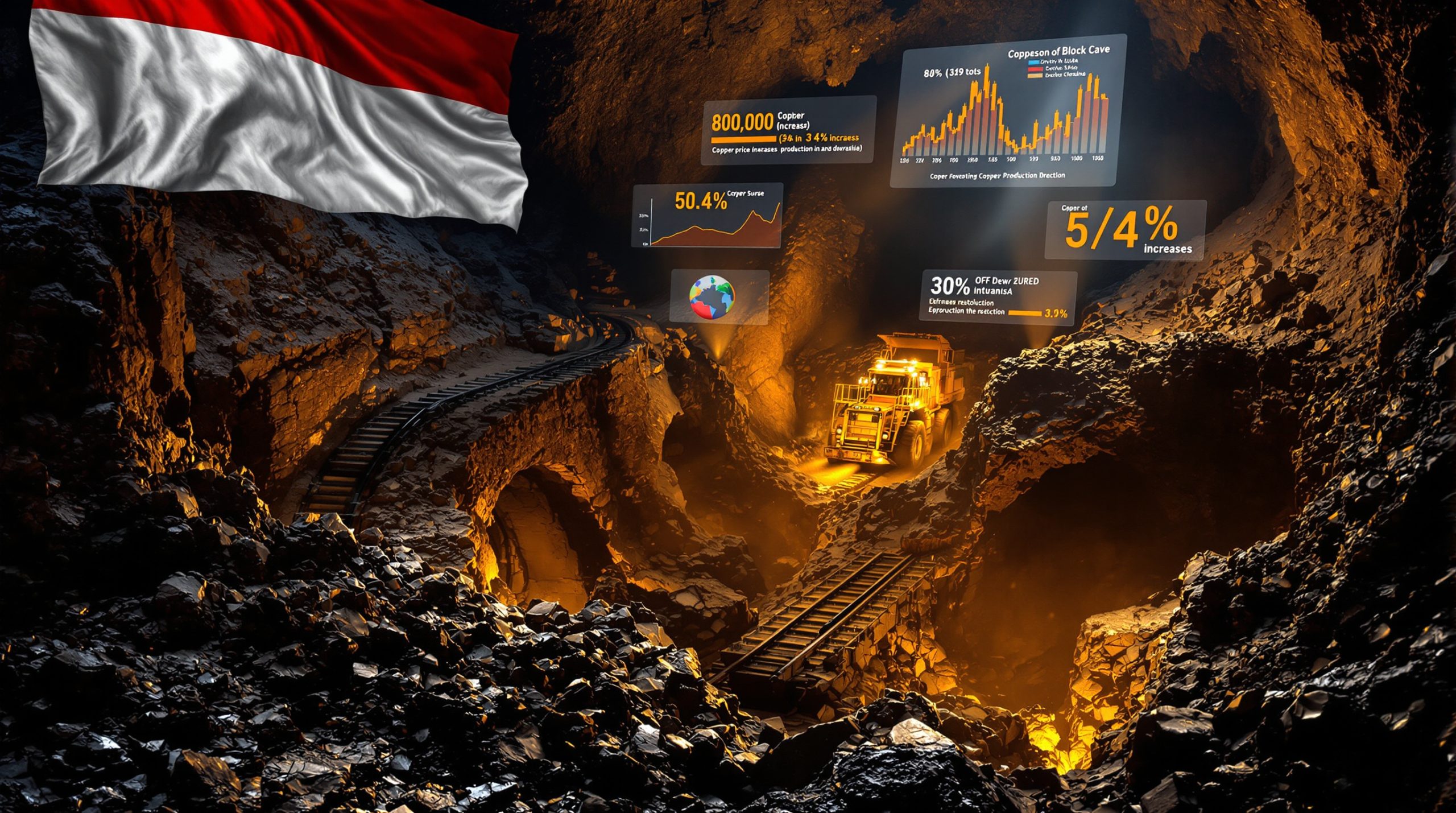Understanding the Current Crisis in Global Copper Smelting
The global copper smelting industry confronts an unprecedented convergence of challenges threatening operational viability worldwide. Treatment and refining charges (TC/RC) have plummeted into negative territory for the first time in industry history, forcing smelters to pay miners for processing concentrate rather than receiving compensation for their services.
The Economics Behind Negative Treatment Charges
Traditional smelting economics relied on TC/RC fees as a fundamental revenue stream, typically ranging from $50-100 per tonne of concentrate processed. However, 2025 witnessed a dramatic reversal with benchmark annual TC/RCs dropping to negative levels. Fastmarkets assessed the weekly copper concentrates TC index at -$66.60 per tonne on October 10, 2025, marking the eighth consecutive week of decline.
This represents a seismic shift in industry dynamics, where smelters must now subsidise mining operations to secure feedstock supply. Furthermore, the negative pricing structure effectively inverts the traditional value chain, creating unprecedented financial pressure on processing facilities globally.
Market Fundamentals Driving the Crisis
The fundamental driver behind this crisis stems from a severe imbalance between smelting capacity and concentrate availability. For instance, the copper smelters market challenges have intensified as global copper supply forecast projections indicate expanding smelting capacity whilst mine production has failed to keep pace with this aggressive growth trajectory.
The concentrate market has been tightening continuously since the loss of Cobre Panama at the end of 2023, creating sustained supply pressure. Industry experts project a deficit of approximately 500,000 tonnes in 2026, similar to 2025 levels. Consequently, this ongoing shortage has driven concentrate inventories lower while prices reflect increasing scarcity premiums.
What Role Does China Play in Global Smelting Market Dynamics?
China's dominance in copper smelting represents both a strategic advantage and a market distortion factor. The country operates approximately 60-65 copper smelters compared to just 15 in Europe and three in North America, controlling the majority of global processing capacity.
Strategic Priorities vs. Market Forces
Chinese smelters maintain high operational rates despite negative margins due to strategic imperatives around domestic copper security. This approach contrasts sharply with Western facilities that must prioritise commercial viability, creating an uneven competitive landscape where market forces apply differently across regions.
The strategic imperative becomes more pronounced as the United States withdraws significant metal volumes from global markets amid tariff concerns. However, this creates additional pressure on China to produce copper domestically rather than rely on imports, further reinforcing the priority of maintaining high run rates regardless of short-term economic losses.
Impact on Global Concentrate Distribution
With half of global copper demand consumed by China, the country's strategic approach to maintaining high run rates prevents the market adjustment that would typically occur through capacity reductions. In addition, this prolongs the current crisis for all market participants by preventing natural supply-demand rebalancing.
China's copper smelters expanding capacity compounds the pressure on treatment charges globally, as new facilities compete aggressively for limited concentrate supplies. Industry projections suggest China will maintain or increase its dominance in the smelting sector over the next five years.
How Are Western Smelters Adapting to Survive?
Western copper smelting operations face unique challenges beyond negative TC/RCs, including higher energy costs, stricter environmental regulations, and limited government support compared to their Chinese counterparts.
Energy Cost Disparities
European smelters face particularly acute cost pressures, with Aurubis paying approximately three times more for energy in Germany compared to its U.S. operations. This structural disadvantage compounds the challenges posed by negative treatment charges and creates significant competitive headwinds for European facilities.
Furthermore, the energy cost differential represents a fundamental competitiveness challenge that cannot be easily addressed through operational efficiency improvements alone. Western smelters must find alternative revenue streams to offset these structural disadvantages.
Regulatory and Permitting Challenges
| Region | Primary Challenge | Impact Level |
|---|---|---|
| Europe | Slow permitting processes, high energy costs | High |
| North America | Environmental compliance, skilled labour shortage | Medium |
| Australia | Distance to markets, infrastructure costs | Medium |
Beyond cost pressures, Western smelters face fundamentally different investment climates. European projects encounter questions about environmental impact, while U.S. investments focus on wealth and job creation. These contrasting attitudes affect capital allocation and project development timelines.
Which Strategies Are Keeping Smelters Operational Despite Losses?
Despite the challenging environment, several factors prevent immediate widespread closures and enable continued operations across the industry.
Byproduct Revenue Streams
Smelters generate significant revenue from byproducts that provide crucial margin support during periods of negative TC/RCs:
- Sulfuric acid production: Traditional revenue source providing substantial cash flow support
- Precious metals recovery: Gold and silver credits offer crucial margin enhancement
- Critical metals extraction: Emerging opportunity for Western facilities seeking competitive advantages
Gold prices above $2,000 per ounce provide substantial support to smelter economics, while silver prices similarly contribute to margins. These precious metal credits have been sufficient to maintain operations despite compressed primary revenue streams from copper processing.
Long-term Contract Structures
Many smelters operate under long-term supply agreements that provide protection against short-term market volatility. These contracts include processing agreements with established mining partners and strategic relationships built over decades of cooperation.
However, these protective mechanisms face increasing pressure during renegotiation periods as market conditions force reassessment of traditional commercial terms. In addition, the copper investment strategies being adopted reflect this challenging environment.
What Is the Critical Metals Strategy for Smelter Survival?
Western smelters increasingly pivot toward critical metals extraction as a pathway to competitiveness and strategic relevance in global supply chains.
Carrier Metal Opportunities
Zinc and lead smelting operations can extract valuable critical materials through specialised processing techniques:
- Antimony: Essential for defence applications including ammunition production
- Germanium: Critical for semiconductor manufacturing and electronic components
- Gallium: Required for advanced electronics and renewable energy applications
- Tellurium: Used in solar panel production and specialised alloys
These materials represent low-tonnage, high-value markets where Western facilities can potentially establish competitive advantages over Chinese operations focused primarily on high-volume base metal production.
Government Support Requirements
Critical metals production requires temporary government support to bridge the transition period, as these materials represent specialised markets vulnerable to supply disruption. Australia's approach to supporting Nyrstar's lead smelter transition provides a model for maintaining processing capacity during challenging market conditions.
The transition requires both immediate financial support and longer-term protection mechanisms against market disruption. Consequently, strategic stockpiling and regional autonomy considerations justify government intervention in critical metals processing capacity.
How Sustainable Are Current Byproduct Revenue Models?
While byproduct credits currently provide crucial support for smelter margins, several factors threaten the long-term viability of this strategy.
Sulfuric Acid Market Pressures
The sulfuric acid market faces potential disruption with approximately 1.5-1.6 million tonnes of demand at risk from possible losses in Chilean oxide leaching operations. This represents a significant threat to a traditional revenue stream that smelters have relied upon for decades.
Market analysts warn that current sulfuric acid pricing cannot be assumed to persist indefinitely, particularly if major demand sources are eliminated through changes in copper processing methods or mine closures.
Precious Metals Price Volatility
Gold and silver prices provide substantial support to current smelter economics, but these elevated levels create dependency on continued precious metal market strength. Industry experts caution against over-reliance on byproducts as a long-term solution, noting that gold prices will not remain at current levels indefinitely.
For instance, the correlation between precious metal prices and smelter profitability creates vulnerability to broader commodity market cycles that could compound the challenges from negative TC/RCs.
What Does the Future Hold for Copper Smelting Capacity?
The outlook for copper smelting presents a complex picture of regional divergence and structural challenges requiring fundamental industry restructuring.
Capacity Adjustment Mechanisms
| Timeframe | Expected Development | Regional Impact |
|---|---|---|
| Next 12 months | Limited capacity reduction | Continued pressure on all facilities |
| 2-5 years | Potential Chinese policy intervention | Gradual market rebalancing |
| 5+ years | Structural industry consolidation | Regional specialisation emergence |
The current margin environment deters new investment in smelting capacity, particularly given high capital requirements for modern, environmentally compliant facilities. This creates a long-term supply constraint that may eventually rebalance markets through reduced expansion rates.
Investment Climate Challenges
Recent examples of Western capacity under pressure include permanent closures and rescue packages for struggling facilities. The investment climate for new smelting capacity remains challenging as traditional financing models prove inadequate under current market conditions.
Environmental compliance requirements and skilled labour shortages compound the challenges facing new capacity development in Western markets. However, decarbonisation in mining initiatives may provide opportunities for modernisation funding.
Which Regions Will Emerge Stronger from the Current Crisis?
Regional competitiveness in copper smelting depends on multiple factors including energy costs, government support, regulatory environment, and strategic positioning.
North American Opportunities
The United States demonstrates potential for smelting capacity development through several competitive advantages:
- Lower energy costs compared to European operations providing structural cost benefits
- Government incentives for domestic mineral processing supporting strategic industries
- Investment climate focused on wealth and job creation rather than environmental constraints
- Strategic focus on supply chain security driving policy support for domestic processing
Furthermore, the us copper production overview highlights potential capacity expansion opportunities. However, the lack of progress during previous policy initiatives raises questions about the likelihood of significant capacity additions in the near term.
Australian Government Support
Australia has demonstrated willingness to provide temporary support for critical metals transitions, offering a model for maintaining processing capacity during challenging market conditions. The government's support for Nyrstar's transition illustrates how targeted intervention can preserve strategic processing capability.
This approach balances immediate commercial challenges with longer-term strategic objectives around regional supply chain autonomy.
When Will Market Conditions Return to Normal?
Industry experts suggest that current conditions represent a structural shift rather than a temporary market disruption requiring fundamental reassessment of traditional business models.
Timeline for Market Rebalancing
The concentrate market is expected to remain very tight through 2026, with deficits of approximately 500,000 tonnes projected. This suggests that current challenging conditions will persist well into the medium term, requiring sustained adaptation strategies rather than short-term survival measures.
Concentrate inventories continue declining while prices reflect increasing scarcity premiums, indicating that fundamental supply-demand imbalances will require extended periods to resolve.
Policy Intervention Potential
Chinese policy changes could eventually provide market relief through capacity restraint measures, similar to interventions that reshaped the aluminium sector over the past decade. However, such changes would likely occur over a five-year timeframe rather than providing immediate relief to current market conditions.
The aluminium market transformation through Chinese policy restraint provides a precedent for how government intervention can address structural oversupply. Nevertheless, the timeline for such changes extends well beyond near-term planning horizons.
What Can Industry Stakeholders Expect Moving Forward?
The current environment necessitates fundamental changes in how stakeholders approach copper smelting investments and operations. Traditional models based solely on treatment charges are proving inadequate for sustained profitability.
Emerging Business Models
Successful smelters are developing diversified revenue streams that extend beyond traditional copper processing:
- Integration with critical metals extraction capabilities
- Strategic partnerships with government agencies for national security materials
- Development of specialised processing techniques for high-value byproducts
- Focus on regional supply chain autonomy rather than global cost competition
These adaptations require significant capital investment and strategic repositioning that many facilities cannot undertake without external support.
Market Consolidation Trends
The copper smelters market challenges will likely accelerate industry consolidation as weaker facilities face closure or acquisition. This consolidation may create opportunities for stronger operators to acquire strategic assets at reduced valuations.
Regional specialisation may emerge, with different facilities focusing on specific competitive advantages rather than competing directly on traditional processing costs.
Navigating the New Reality of Copper Smelting
The copper smelters market challenges represent a fundamental restructuring as traditional business models prove inadequate for current conditions. Success requires adaptation through critical metals strategies, government partnerships, and operational efficiency improvements that go far beyond conventional cost-cutting measures.
While the current crisis creates significant challenges for all market participants, it also presents opportunities for well-positioned facilities to establish competitive advantages in an evolving market landscape. The facilities that emerge stronger will be those that successfully diversify revenue streams, secure strategic government support, and position themselves within critical supply chains rather than relying solely on traditional smelting economics.
For instance, the copper price insights suggest that market fundamentals will continue supporting long-term demand despite near-term processing challenges. This creates opportunities for strategic positioning during the current downturn.
The industry faces an extended period of adjustment as market forces work to rebalance supply and demand fundamentals. This adjustment period will likely result in regional specialisation, with different facilities focusing on specific competitive advantages whether through cost structures, critical metals capabilities, or strategic positioning within supply chains essential to national security objectives.
Disclaimer: This analysis is based on market conditions and expert opinions as of October 2025. Commodity markets are subject to rapid changes due to geopolitical events, policy changes, and economic factors. Investment decisions should be made only after consulting with qualified financial advisors and conducting thorough due diligence.
Ready to Capitalise on Copper Market Opportunities?
Discovery Alert's proprietary Discovery IQ model delivers real-time alerts on significant copper and mineral discoveries across the ASX, transforming complex market dynamics into actionable insights that position subscribers ahead of the broader market. Understand why major mineral discoveries can lead to substantial market returns by exploring Discovery Alert's dedicated discoveries page, showcasing historic examples of exceptional outcomes, and begin your 30-day free trial today to secure your market-leading advantage.




